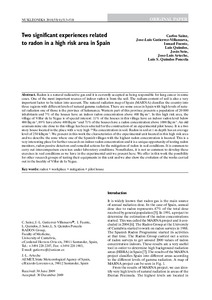Por favor, use este identificador para citar o enlazar este ítem:
http://hdl.handle.net/20.500.11765/11787
Two significant experiences related to radon in a high risk area in Spain
| Título : | Two significant experiences related to radon in a high risk area in Spain |
| Autor : | Sainz, Carlos; Gutiérrez Villanueva, José Luis; Fuente Merino, Ismael; Quindós López, Luis; Soto Velloso, Jesús; Arteche García, José Luis

|
| Palabras clave : | Radon; Workplace; Mitigation; Pilot house |
| Fecha de publicación : | 2010 |
| Editor: | Institute of Nuclear Chemistry and Technology |
| Citación : | Nukleonika. 2010, 55(4), p. 513−518 |
| Resumen : | Radon is a natural radioactive gas and it is currently accepted as being responsible for lung cancer in some cases. One of the most important sources of indoor radon is from the soil. The radium content of soil is also a very important factor to be taken into account. The natural radiation map of Spain (MARNA) classifies the country into three regions with different levels of natural gamma radiation. There are some areas in Spain with high levels of natural radiation one of those is the province of Salamanca. Western part of this province presents a population of 20 000 inhabitants and 7% of the houses have an indoor radon concentration above 400 Bq•m–3. In this high risk area, the village of Villar de la Yegua is of special interest: 11% of the houses in this village have an indoor radon level below 400 Bq•m–3, 89% have above 400 Bq•m–3 and 71% of the houses have a radon concentration above 1000 Bq•m–3. An old uranium mine site close to this village has been selected for the construction of an experimental pilot house. It is a two story house located in the place with a very high 226Ra concentration in soil. Radon in soil at 1 m depth has an average level of 250 kBq•m–3. We present in this work the characteristics of the experimental unit located in this high risk area and we describe the zone where one of the Spanish villages with the highest radon concentration is located. This is a very interesting place for further research on indoor radon concentration and it is a unique opportunity of testing radón monitors, radon passive detectors and remedial actions for the mitigation of radon in real conditions. It is common to carry out intercomparison exercises under laboratory conditions. Nonetheless, it is not so common to develop these exercises in real conditions as we have in the experimental unit we present here. We offer in this work the possibility for other research groups of testing their equipments in this unit and we also show the evolution of the works carried out in the locality of Villar de la Yegua. |
| Descripción : | Número monográfico dedicado al "Proceedings of the International Conference Radon in Environment 2009” |
| URI : | http://hdl.handle.net/20.500.11765/11787 |
| ISSN : | 0029-5922 1508-5791 |
| Colecciones: | Artículos científicos 2010-2014 |
Ficheros en este ítem:
| Fichero | Descripción | Tamaño | Formato | ||
|---|---|---|---|---|---|
| sainz2010_nukleonika.pdf | 519,72 kB | Adobe PDF |  Visualizar/Abrir |
Los ítems de Arcimis están protegidos por una Licencia Creative Commons, salvo que se indique lo contrario.





